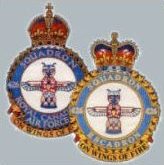Lancaster
About 7400 Avro Lancasters were built, almost all of them powered by four Rolls-Royce Merlin in-line, liquid-cooled engines. The exception was the Lancaster Mk II, of which one prototype and 300 production models were built at Baginton, Warwickshire, by Armstrong-Whitworth Aircraft Ltd. These bombers were fitted with the Bristol Hercules radial air-cooled engine, the same power plant used on the Wellington and Halifax, making conversion between them easier. The Lancaster had a crew of up to seven, a maximum speed of 264 mph, a service ceiling of 18500 feet, and a range of 2547 miles. It could carry one 22000 pound bomb, or up to 18000 pounds of smaller bombs. For defensive armament it had eight .303 calibre Browning machine guns.
The Lancaster phase of No 426 Squadron lasted nine and a half months, July 43 to April 44, and both air and ground crews parted with the aircraft reluctantly. The unit flew the Lanky on fifty-eight operations, comprising 605 sorties, of which 515 were completed and sixty-two were abandoned. In the same period, aircraft and crews were readied for forty missions that were canceled for various operational reasons.
During this phase, the squadron paid a high price. Thirty-three aircraft were lost: twenty-seven disappeared over continental Europe; one ditched; three crashed on return from operations; one crashed in Sweden; and one crashed at sea. In addition, many of these bombers had been heavily damaged by flak or by fire from enemy aircraft, and repeatedly repaired and returned to service.
When Lancasters were lost, men were usually lost with them. Aircrew casualties included: 171 killed; thirty-four taken prisoner, two of whom would die in captivity; ten injured, one of whom died of his injuries; two evaders, who both would return to England; seven interned in Sweden; and a borrowed crew from No 408 Squadron who ditched and were rescued.




An unidentifed Thunderbird air and ground crew.

This model of a Thunderbird Lancaster getting ‘bombed up’, was constructed by Capt W. Sturgeon and MCpl R. Nielson in 81, and is housed in the main display case between the entrances of Blanchard Hall, Dishforth Building, Trenton.

